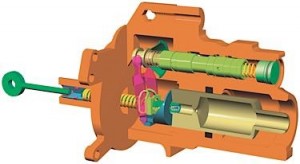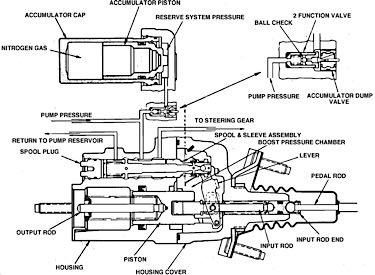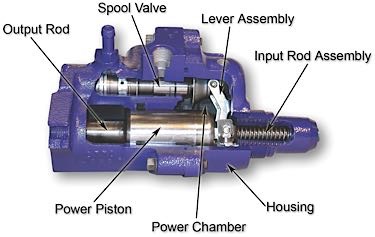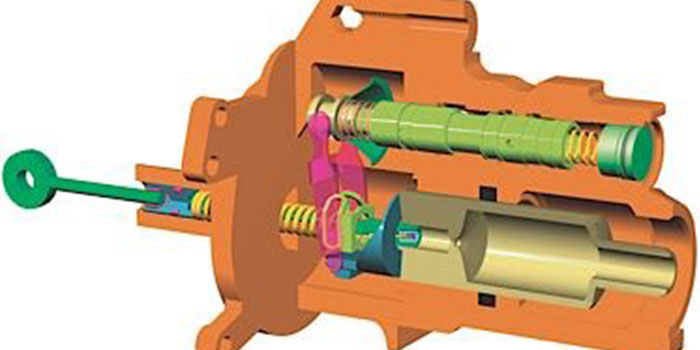 Hydro-boost brake boosters can be mysterious to the untrained technician because part-swapping will not solve some brake issues. These systems use the pressure of the power steering pump to power the brake booster. The booster is essentially a power steering unit that supplements the driver’s input.
Hydro-boost brake boosters can be mysterious to the untrained technician because part-swapping will not solve some brake issues. These systems use the pressure of the power steering pump to power the brake booster. The booster is essentially a power steering unit that supplements the driver’s input.
When hydro-boost was first introduced in medium-duty trucks in the 1970s, the system was designed to solve issues associated with the safety and fuel-efficiency mandates of the day.
These worked because they produce more boost than a vacuum booster. Second, the units are compact enough to fit in spaces a vacuum booster can’t, like on vans. Lastly, they aid diesel vehicles that can’t produce enough engine vacuum.
Hydro-boost vehicles are not hard to work on and typically don’t require special tools, but they do require service information and a working knowledge of the system.
1. Listen
Properly operating hydro-boost units will produce certain noises not heard in vacuum booster systems. These noises occur, for the most part, when the brake pedal is manipulated in a manner not associated with everyday driving habits. The general categories of normal operating noises are hissing and clunk/clatter noises.
2. Basic Function Test
To check if a hydro-boost system is functioning, perform this test:
1. With the engine off, pump the brake pedal until it is hard.
2. Start the engine.
3. Proper operation should result in the brake pedal sinking down and then pushing back up against your foot.
The sinking of the pedal when the engine was started is a result of the power chamber being pressurized. Once the power steering system is at full pressure, the pedal pushes back against your foot pressure.
This test will only verify if the pump, hydro-boost unit and reserve are working. This test will not diagnose performance problems of certain customer complaints.
3. Check The Service Information For Correct Test Procedure
The basic function test can only tell you if the system is functioning — it will not tell you how well the system is functioning. Many OE test procedures have specific rpm ranges and steering wheel movements to determine the health of the system. Look them up.
 4. Hoses Are Safety Items
4. Hoses Are Safety Items
Power steering hoses are just as important as brake hoses. Inspect all power steering hoses, which include hoses that connect only the power steering gear to the pump. If a leaking or soft, spongy hose is found anywhere in the system, replace all hoses. If any one hose is bad, the others are likely ready to fail.
Not all hose defects can be detected from outward inspection because they usually fail from the inside out. Deteriorated hoses produce debris, which will damage all parts of the system, including the hydro-boost unit.
5. Flush The System
The spool valve fits into a precisely machined bore that is part of the hydro-boost housing. The fit between the spool valve and the bore is such that it creates a seal while allowing enough fluid between the lands and bore to provide lubrication. The tolerances of the moving parts inside the hydro-boost are such that even a small amount of contaminants can cause a malfunction. This is especially true of the spool valve. The tolerances necessary to form a metal-to-metal seal are quite small and any contaminants or tarnish buildup can prevent smooth operation of the spool valve. A properly functioning spool valve is critical because it controls the flow of fluid in and out of the power chamber.
Any vehicle equipped with a hydro-boost power assist will benefit from a periodic power steering flush, but there is an additional step you have to perform to ensure the hydro-boost power chamber and internal parts are flushed. When performing the flush, apply and release the brake pedal slowly to allow the new fluid into the hydro-boost. If you skip this step, you will have a large quantity of old fluid in the hydro-boost that will mix with the new fluid once the brake is applied and released a couple of times.
 6. Look For Leaks
6. Look For Leaks
Any leak on the hydro-boost unit is grounds for replacement. Look for leaks on the end caps, housings and firewall. Leaks will cause a sinking or long-pedal condition.
7. Bleeding
Hydro-boost brake systems are self-bleeding if there is no other problem in the system. Use this initial bleeding procedure whenever replacing or servicing any component in a hydro-boost system. Normal driving conditions will remove air that remains trapped within the system when components are properly installed and there are no flow restrictions in the system. Always refer to the vehicle service manual for specific installation and testing procedures.
8. Check The Cooler
Like the power steering gear, the hydro-boost unit does not like to be overheated. Some off-road maneuvers or use of large tires can cause the fluid temperature to skyrocket. This can damage the seals and spool valve. If your customer has a lifted truck with large tires, recommend a power steering cooler to save the brakes.
9. Adjustments To The Pedal And Master Cylinder
Most hydro-boost replacements fall off the rails during an adjustment to the rods that attach to the brake pedal and master cylinder. The input and output rods must be the correct length for the spool valve and master to operate properly. Older systems are adjustable and require measuring the rods and flange. Newer systems may not have any adjustments. Check the service information and measure the old unit if possible.
10. Check The Belt
Check the tension and condition of the drive belt and tensioner as part of any brake inspection. A belt that is worn or a tensioner that is weak can cause performance issues under high pump load. This can include a low pedal and noise.
Courtesy Brake & Front End.














